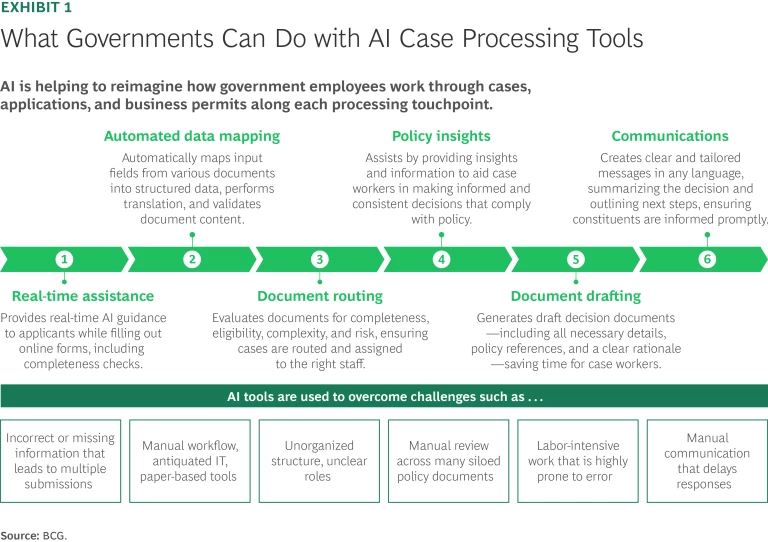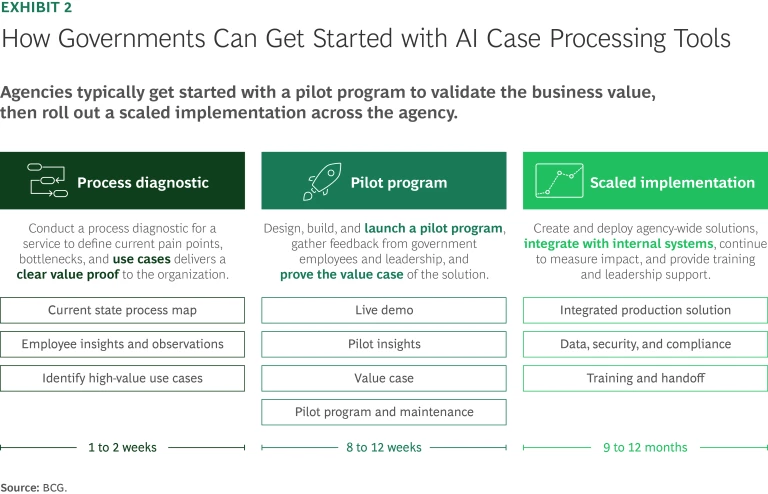Governments are under mounting pressure to deliver on rising citizen expectations while managing budgets during an era of constant regulatory change. The strain is harming an essential aspect of governments’ relationship with the public: trust. Generative AI is the ideal resource to help reshape core government processing functions, profoundly improve citizen experiences, and restore faith in public services.
Solutions like AI agents—next-generation models that provide context and complete tasks autonomously—are helping public servants reengineer manual processes and push through dense backlogs. With well-designed digital tools and thoughtful change management, workers can make decisions faster and undertake more efficient case processing, a vital part of service delivery.
Agencies that deploy AI fully can also save significantly on costs. Traditional cost optimization yields 10%–15% savings; by applying new AI technologies to specific areas such as case processing, governments can save up to 35% of budget costs in impacted areas over the next ten years.
But using AI isn’t only about technology; the strategy to spur adoption also calls for an employee-centric approach to optimizing processes. BCG has observed that 70% of the efforts are focused on people and process improvements. By prioritizing change management, public sector agencies around the world are finding greater ROI and productivity gains—saving hours or even days of processing time per application.
Stay ahead with BCG insights on the public sector
The GenAI Opportunity in Government Processing
The opening to take advantage of GenAI solutions for government processing could not be more timely, with governments facing increasing budget deficits, mounting administrative backlogs, rising citizen expectations for digital services, and persistent job vacancies. The staffing challenges are exacerbated by consistent workforce attrition.
AI agents can engage interactively with citizen applicants. Models can take in vast quantities of unstructured data and measure it against preset criteria, speeding analysis. Large language models can quickly synthesize findings into prose, producing reports much faster. These capabilities are a great fit for an essential function like government case processing.
Through our work with government clients around the world, we have observed a set of common functions within case processing that GenAI is ideally suited to address. (See Exhibit 1.) Deploying AI to handle these functions leads to immediate results.

Real-Time Assistance for Applicants. When a member of the public starts the seemingly simple process of filling out a form, they often run into unclear guidance and eligibility criteria. Calls to help lines pile up.
AI solutions can optimize call centers and digital engagement channels to provide in-the-moment help to applicants. AI is suited to triaging citizen needs, answering frequently asked questions, and routing inquiries to the right channels. A department of motor vehicles in a US southeastern state used such a solution to reduce unanswered public calls by 6% within just two months.
Automated Data Mapping. Government workers often process paper-based or unstructured applications by hand, and AI offers a welcome improvement to these workflows.
A health and human services state agency in the US used AI mapping to make hiring more efficient, with AI quickly mapping key answers into a one-page view for the human reviewers, saving time and letting staff focus on assessing the candidate’s fit for the job. Early users noted that the tool not only saved them time in a tedious task but also boosted their comprehensiveness and accuracy when conducting and documenting their reviews.
Document Evaluation and Routing. Assessing documents for completeness, eligibility, and risk can be a slow undertaking. Manual processes further slow routing of the documents to the right department. AI solutions can process documents faster and more accurately by applying consistent rules and highlighting nuances for human review.
A federal agency in one EU country used AI technology to process unstructured data and multimodal information to streamline permit review for wind turbines. This helped reduce the time spent on compliance checks from 8+ hours per document to under 20 minutes while ensuring consistent application of laws, adaptation to regulatory change, more reliability and transparency, and support in decision making.
- Quick Access to Policy Facts. Clear policy details are vital to avoid delays in making and documenting decisions. AI tools help bring clarity to policy by synthesizing and sharing knowledge quickly. (See the sidebar, “Processing Criminal Injury Claims with GenAI.”)
- Document Drafting and Citizen Communication. Government workers should communicate with citizens through clear, professional, and polite messages. Automated tools can draft communications in various languages; models can add useful evidence and logic to reports. Workers at the aforementioned health and human services agency cited that AI-drafted communications included more detailed information on historical precedents; this depth further substantiated government records and improved accuracy and consistency of decisions.
Processing Criminal Injury Claims with GenAI
The agency’s leaders set a goal of faster, more accurate decision making. The BCG team worked with their policy, legal, and operational experts to create a GenAI copilot that helped case workers navigate hundreds of pages of guidance and policy faster and more accurately. The legal and policy teams also analyzed the robustness of the tool through an extensive process of testing and refinement of output accuracy.
As a result, case officers can find the right information more efficiently, which is expected to lead to an 80-day reduction in the average time to process a case.
Where to Start
Government agencies often have multiple case processing workflows that are inherently complex with multiple handoffs and multiple approvals. As leaders begin their journey with AI, they can look to start deploying technology in areas that will quickly drive business value for the organization and meet four conditions:
- Widely Acknowledged Trouble Spots. Aim to identify burdensome, frustrating work and use AI to handle or ease these tasks.
- High-Volume Activities. Look for the busiest area of work, which often makes for a clear value case for AI, especially when any productivity gains can be scaled.
- Areas of Lower Risk. Look for areas where there is already some degree of social license, acceptance, tolerance, or event adoption of technology, and ensure risks around legal and ethical use of technology are managed.
- Independently Owned Processes. Avoid specific processes or focus areas that require significant cross-agency collaboration, which can create roadblocks before the value case has been defined.
Deployment of AI in the public sector isn’t as straightforward as plugging in an off-the-shelf solution. Once agencies have selected a starting case process flow, teams can begin with a human-centric approach to design and deploy impactful solutions. Through our work with governments around the world, we’ve learned that for many organizations engaging AI, 10% of the effort lies in algorithms, 20% in enabling technology and infrastructure, and 70% in the most important area, people and processes. In government, there often needs to be an even stronger emphasis on process optimization and change management.
A curated solution strategy must hinge on relentless focus on business value, including improved citizen satisfaction and productivity gains. To unlock this value, it is imperative to design with the end-user in mind—particularly for core processing functions, where government workers today know what they need to be more effective and supported. To get the best impact from AI, it is paramount to design models and workflows to workers’ specific needs.
70%: Prioritize people and processes as the primary drivers for change.
- Work to identify a specific challenge that meets the conditions mentioned above. This is the ideal place to start your AI implementation; design curated tech-enabled processes that minimize change to workers’ day to day.
- Listen closely to government workers to map current processes and pain points. They are the ones who can pinpoint the right capabilities—human or AI—to solve the backlog.
- Leverage off-the-shelf tools where applicable to accelerate identification of challenges in current state processes.
- Commit to involve workers in every phase of the journey, from identifying use cases to user testing and launch—they’ll invest more deeply in their own adoption of the solution.
- Understand the business case and measure the value by quantifying the impacts of the AI solution for workers and citizens. Set goals to scale that impact in the future.
20%: Configure new technology to work seamlessly with current platforms and optimized workflows.
- Understand how GenAI fits with current technology platforms and where it can fill gaps.
- Plan to partner early with technology vendors, organizational leadership, and workers to define technical requirements of the solution.
- Work with technology vendors and informational technology teams to understand the scope of current technology platforms; lay out how the solution can work with current infrastructure to fill gaps.
- Test early-stage prototypes continuously with users; always build solutions to embed with current user experiences.
- Appoint organizational leadership to steadily revisit potential strategies with technologists; this accelerates build time while balancing customization to meet the discrete needs of the worker.
10%: Rigorously test algorithms for error and bias.
- Prioritize early and regular testing of solution against responsible technology principles, seeking input from business vendors with deep experience and commitment to responsible AI practices.
Agencies should look to prove value to the citizen and organization during the pilot phase before moving to scaled implementation. (See Exhibit 2.) We often see agencies start with a rapid diagnostic that demonstrates value for the selected case processing workstream before moving into an interactive test-and-build pilot program.

Well-deployed AI solutions improve the citizen experience, reduce administration burden for government workers leading to higher job satisfaction and reduced workforce attrition and vacancies.
This isn’t a distant vision. The value for government agencies is genuine, significant, and can be realized in weeks and months, not years.













